BBE207 - Community and Industrial Relations: Stakeholder Report
VerifiedAdded on 2023/06/13
|28
|7409
|321
Report
AI Summary
This report provides an overview of the Australian industrial relations system, its history, and the principles of conciliation and arbitration. It discusses the evolution of industrial relations from the 1990s to the present, highlighting key legislative changes like the Fair Work Act 2009 and the Building and Construction Industry (Improving Productivity) Act 2016. The report identifies key stakeholders, including the government, trade unions, employer associations, and the community, and examines their roles in enforcing legislation and resolving disputes. It also touches upon the impact of the Royal Commission into Trade Union Governance and Corruption and the future of industrial relations in Australia. Desklib offers a wealth of resources, including past papers and solved assignments, for students studying similar topics.
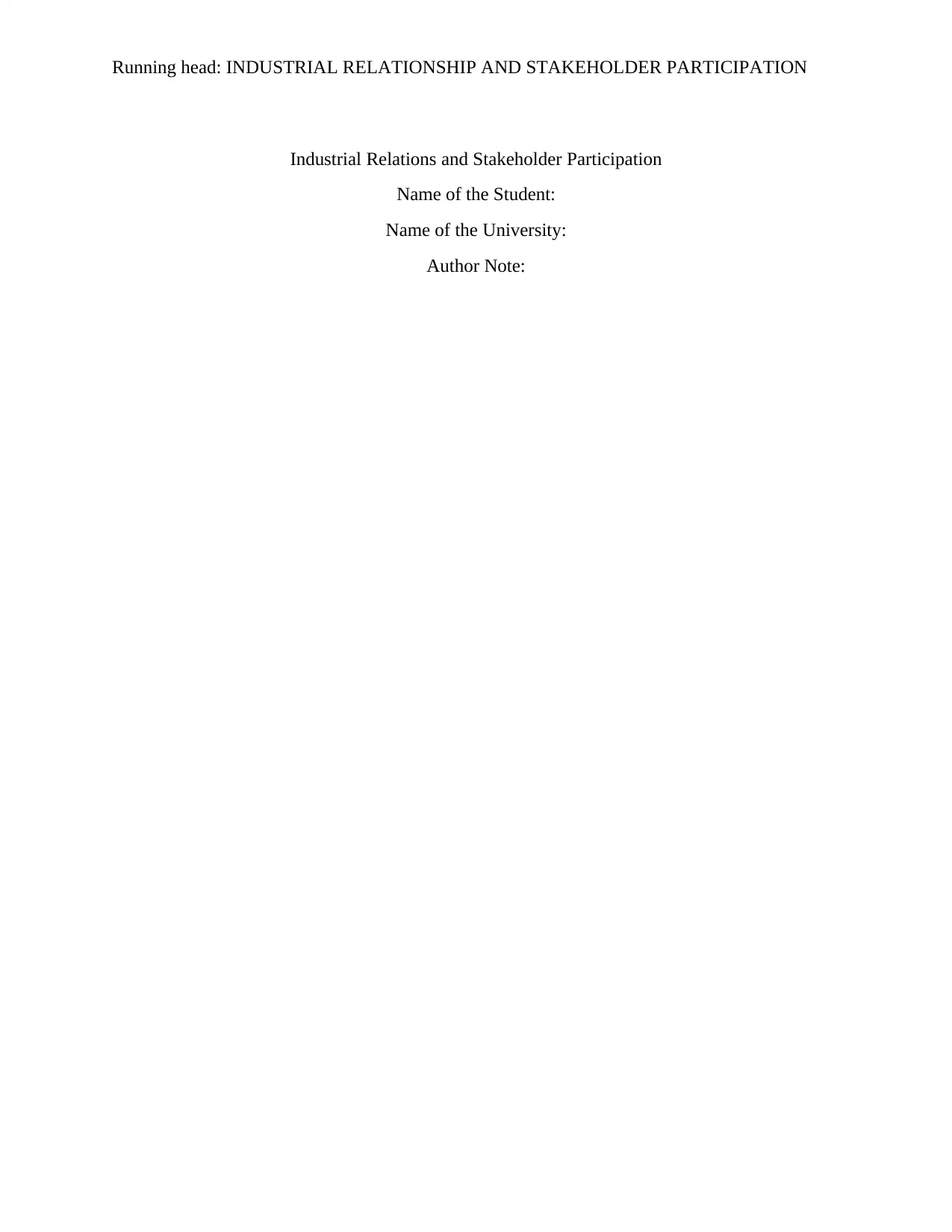
Running head: INDUSTRIAL RELATIONSHIP AND STAKEHOLDER PARTICIPATION
Industrial Relations and Stakeholder Participation
Name of the Student:
Name of the University:
Author Note:
Industrial Relations and Stakeholder Participation
Name of the Student:
Name of the University:
Author Note:
Paraphrase This Document
Need a fresh take? Get an instant paraphrase of this document with our AI Paraphraser
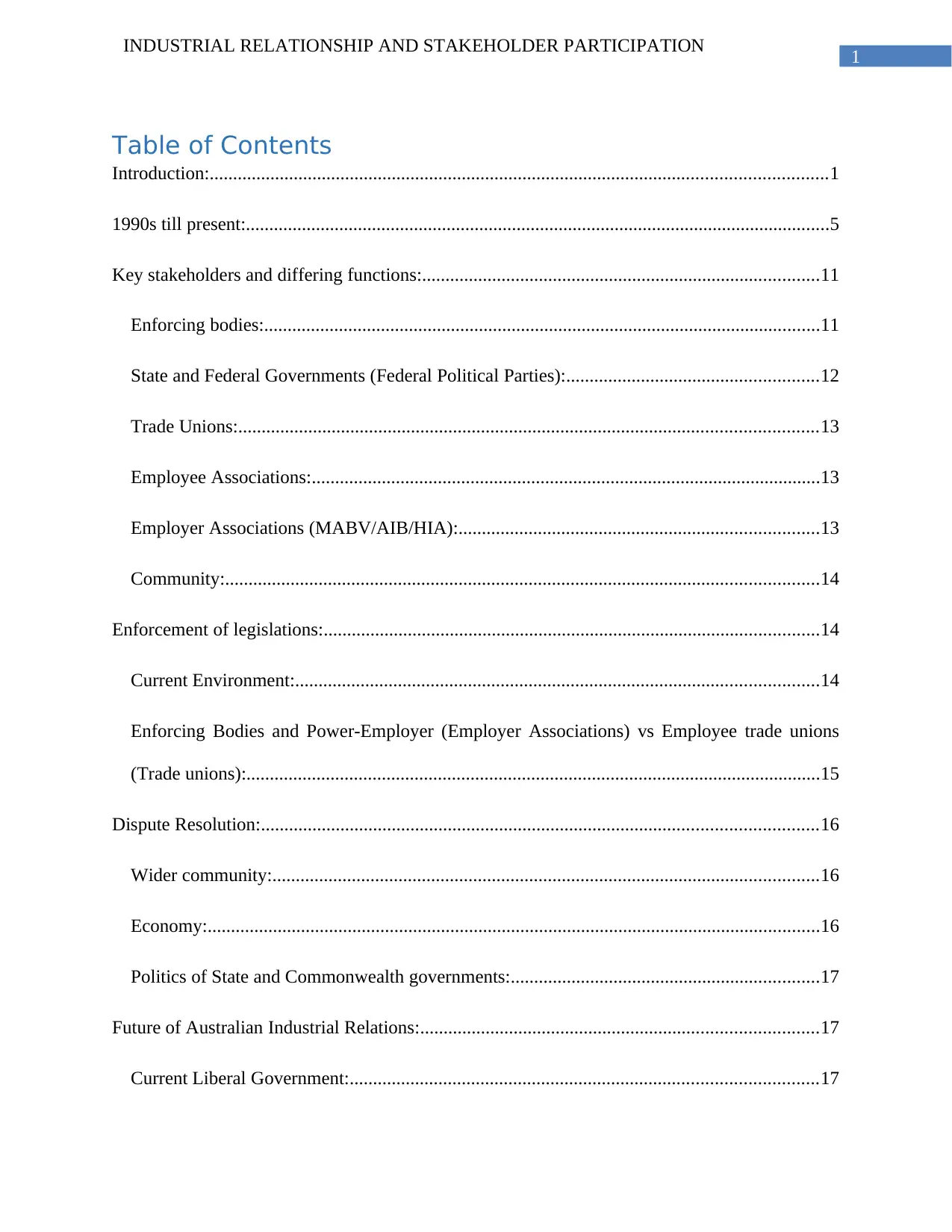
1
INDUSTRIAL RELATIONSHIP AND STAKEHOLDER PARTICIPATION
Table of Contents
Introduction:....................................................................................................................................1
1990s till present:.............................................................................................................................5
Key stakeholders and differing functions:.....................................................................................11
Enforcing bodies:.......................................................................................................................11
State and Federal Governments (Federal Political Parties):......................................................12
Trade Unions:............................................................................................................................13
Employee Associations:.............................................................................................................13
Employer Associations (MABV/AIB/HIA):.............................................................................13
Community:...............................................................................................................................14
Enforcement of legislations:..........................................................................................................14
Current Environment:................................................................................................................14
Enforcing Bodies and Power-Employer (Employer Associations) vs Employee trade unions
(Trade unions):...........................................................................................................................15
Dispute Resolution:.......................................................................................................................16
Wider community:.....................................................................................................................16
Economy:...................................................................................................................................16
Politics of State and Commonwealth governments:..................................................................17
Future of Australian Industrial Relations:.....................................................................................17
Current Liberal Government:....................................................................................................17
INDUSTRIAL RELATIONSHIP AND STAKEHOLDER PARTICIPATION
Table of Contents
Introduction:....................................................................................................................................1
1990s till present:.............................................................................................................................5
Key stakeholders and differing functions:.....................................................................................11
Enforcing bodies:.......................................................................................................................11
State and Federal Governments (Federal Political Parties):......................................................12
Trade Unions:............................................................................................................................13
Employee Associations:.............................................................................................................13
Employer Associations (MABV/AIB/HIA):.............................................................................13
Community:...............................................................................................................................14
Enforcement of legislations:..........................................................................................................14
Current Environment:................................................................................................................14
Enforcing Bodies and Power-Employer (Employer Associations) vs Employee trade unions
(Trade unions):...........................................................................................................................15
Dispute Resolution:.......................................................................................................................16
Wider community:.....................................................................................................................16
Economy:...................................................................................................................................16
Politics of State and Commonwealth governments:..................................................................17
Future of Australian Industrial Relations:.....................................................................................17
Current Liberal Government:....................................................................................................17
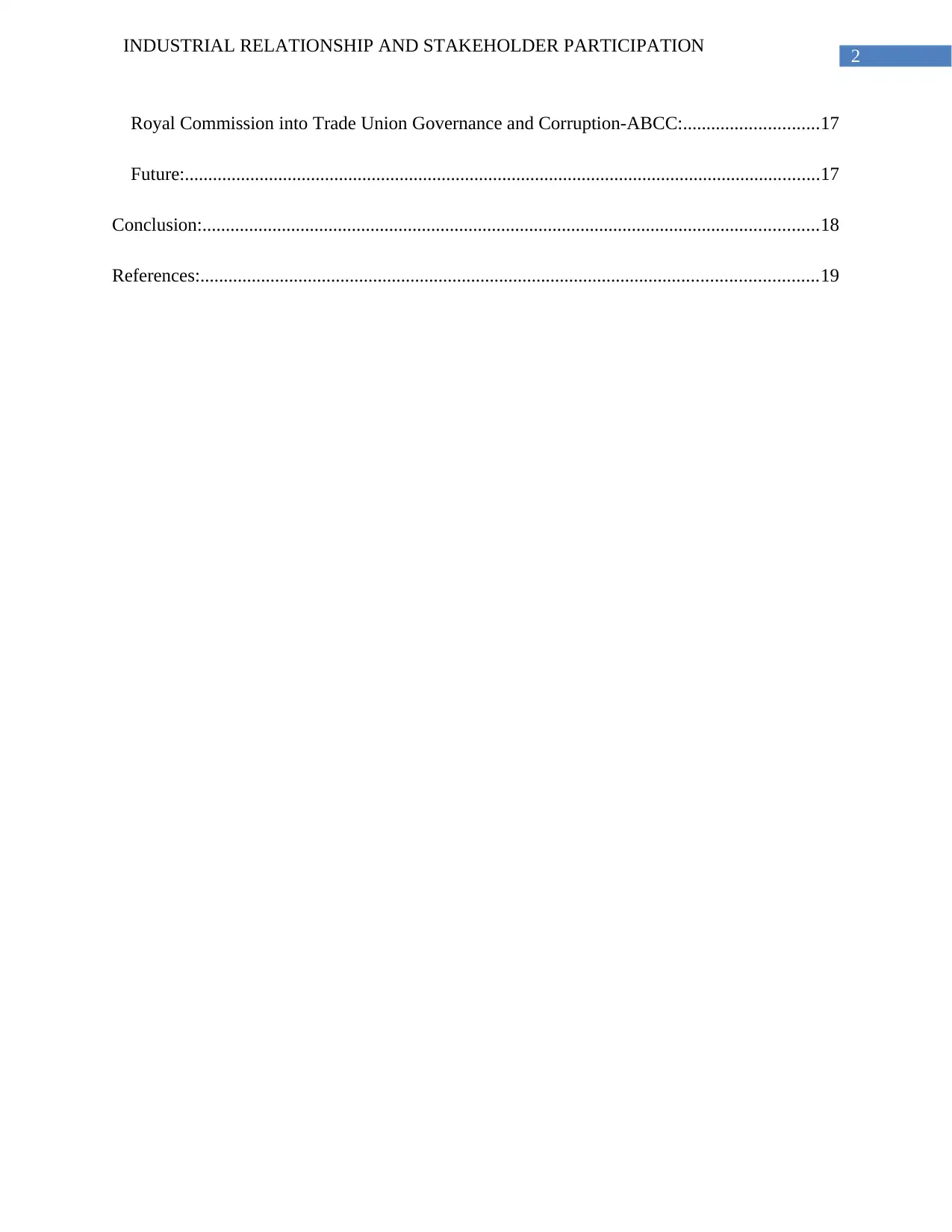
2
INDUSTRIAL RELATIONSHIP AND STAKEHOLDER PARTICIPATION
Royal Commission into Trade Union Governance and Corruption-ABCC:.............................17
Future:........................................................................................................................................17
Conclusion:....................................................................................................................................18
References:....................................................................................................................................19
INDUSTRIAL RELATIONSHIP AND STAKEHOLDER PARTICIPATION
Royal Commission into Trade Union Governance and Corruption-ABCC:.............................17
Future:........................................................................................................................................17
Conclusion:....................................................................................................................................18
References:....................................................................................................................................19
⊘ This is a preview!⊘
Do you want full access?
Subscribe today to unlock all pages.

Trusted by 1+ million students worldwide
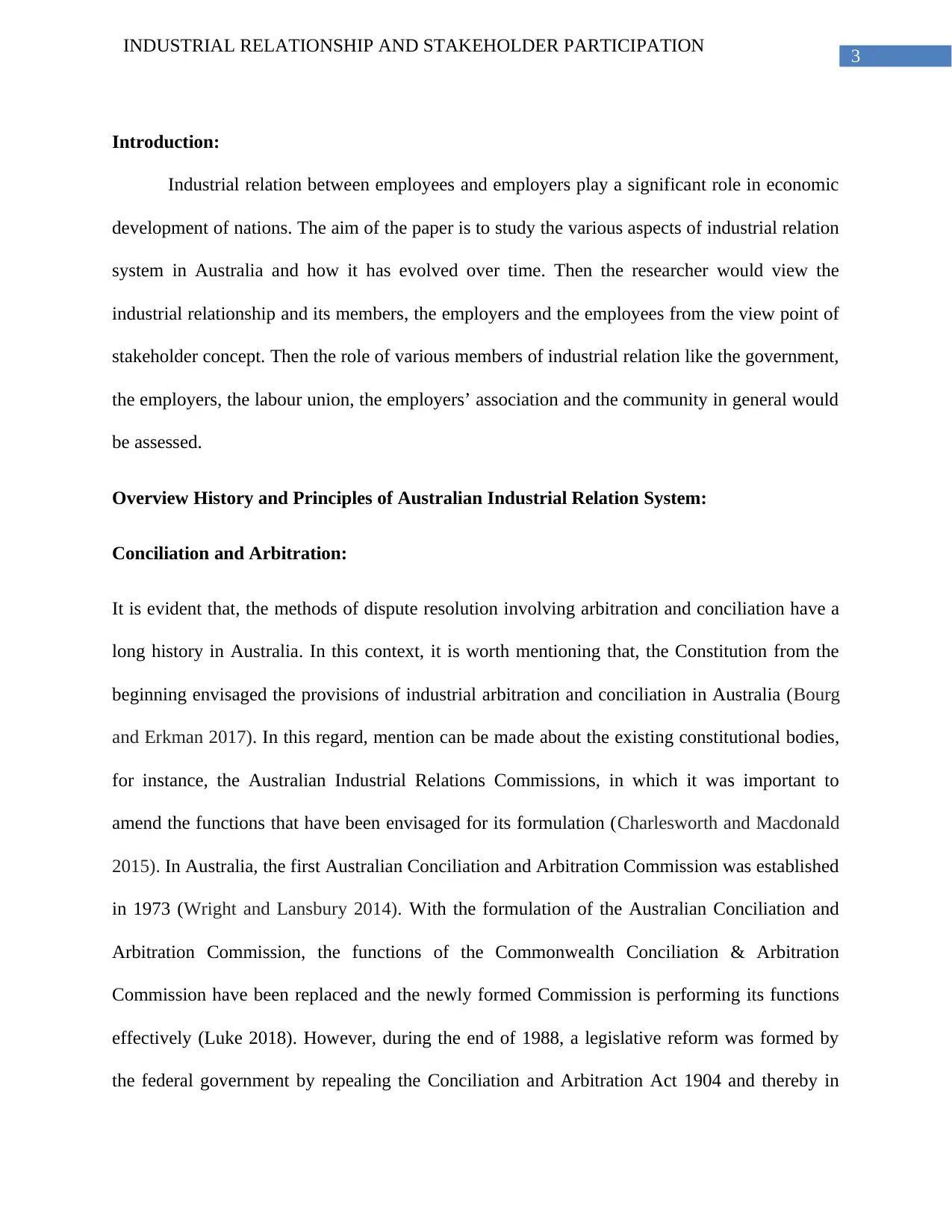
3
INDUSTRIAL RELATIONSHIP AND STAKEHOLDER PARTICIPATION
Introduction:
Industrial relation between employees and employers play a significant role in economic
development of nations. The aim of the paper is to study the various aspects of industrial relation
system in Australia and how it has evolved over time. Then the researcher would view the
industrial relationship and its members, the employers and the employees from the view point of
stakeholder concept. Then the role of various members of industrial relation like the government,
the employers, the labour union, the employers’ association and the community in general would
be assessed.
Overview History and Principles of Australian Industrial Relation System:
Conciliation and Arbitration:
It is evident that, the methods of dispute resolution involving arbitration and conciliation have a
long history in Australia. In this context, it is worth mentioning that, the Constitution from the
beginning envisaged the provisions of industrial arbitration and conciliation in Australia (Bourg
and Erkman 2017). In this regard, mention can be made about the existing constitutional bodies,
for instance, the Australian Industrial Relations Commissions, in which it was important to
amend the functions that have been envisaged for its formulation (Charlesworth and Macdonald
2015). In Australia, the first Australian Conciliation and Arbitration Commission was established
in 1973 (Wright and Lansbury 2014). With the formulation of the Australian Conciliation and
Arbitration Commission, the functions of the Commonwealth Conciliation & Arbitration
Commission have been replaced and the newly formed Commission is performing its functions
effectively (Luke 2018). However, during the end of 1988, a legislative reform was formed by
the federal government by repealing the Conciliation and Arbitration Act 1904 and thereby in
INDUSTRIAL RELATIONSHIP AND STAKEHOLDER PARTICIPATION
Introduction:
Industrial relation between employees and employers play a significant role in economic
development of nations. The aim of the paper is to study the various aspects of industrial relation
system in Australia and how it has evolved over time. Then the researcher would view the
industrial relationship and its members, the employers and the employees from the view point of
stakeholder concept. Then the role of various members of industrial relation like the government,
the employers, the labour union, the employers’ association and the community in general would
be assessed.
Overview History and Principles of Australian Industrial Relation System:
Conciliation and Arbitration:
It is evident that, the methods of dispute resolution involving arbitration and conciliation have a
long history in Australia. In this context, it is worth mentioning that, the Constitution from the
beginning envisaged the provisions of industrial arbitration and conciliation in Australia (Bourg
and Erkman 2017). In this regard, mention can be made about the existing constitutional bodies,
for instance, the Australian Industrial Relations Commissions, in which it was important to
amend the functions that have been envisaged for its formulation (Charlesworth and Macdonald
2015). In Australia, the first Australian Conciliation and Arbitration Commission was established
in 1973 (Wright and Lansbury 2014). With the formulation of the Australian Conciliation and
Arbitration Commission, the functions of the Commonwealth Conciliation & Arbitration
Commission have been replaced and the newly formed Commission is performing its functions
effectively (Luke 2018). However, during the end of 1988, a legislative reform was formed by
the federal government by repealing the Conciliation and Arbitration Act 1904 and thereby in
Paraphrase This Document
Need a fresh take? Get an instant paraphrase of this document with our AI Paraphraser
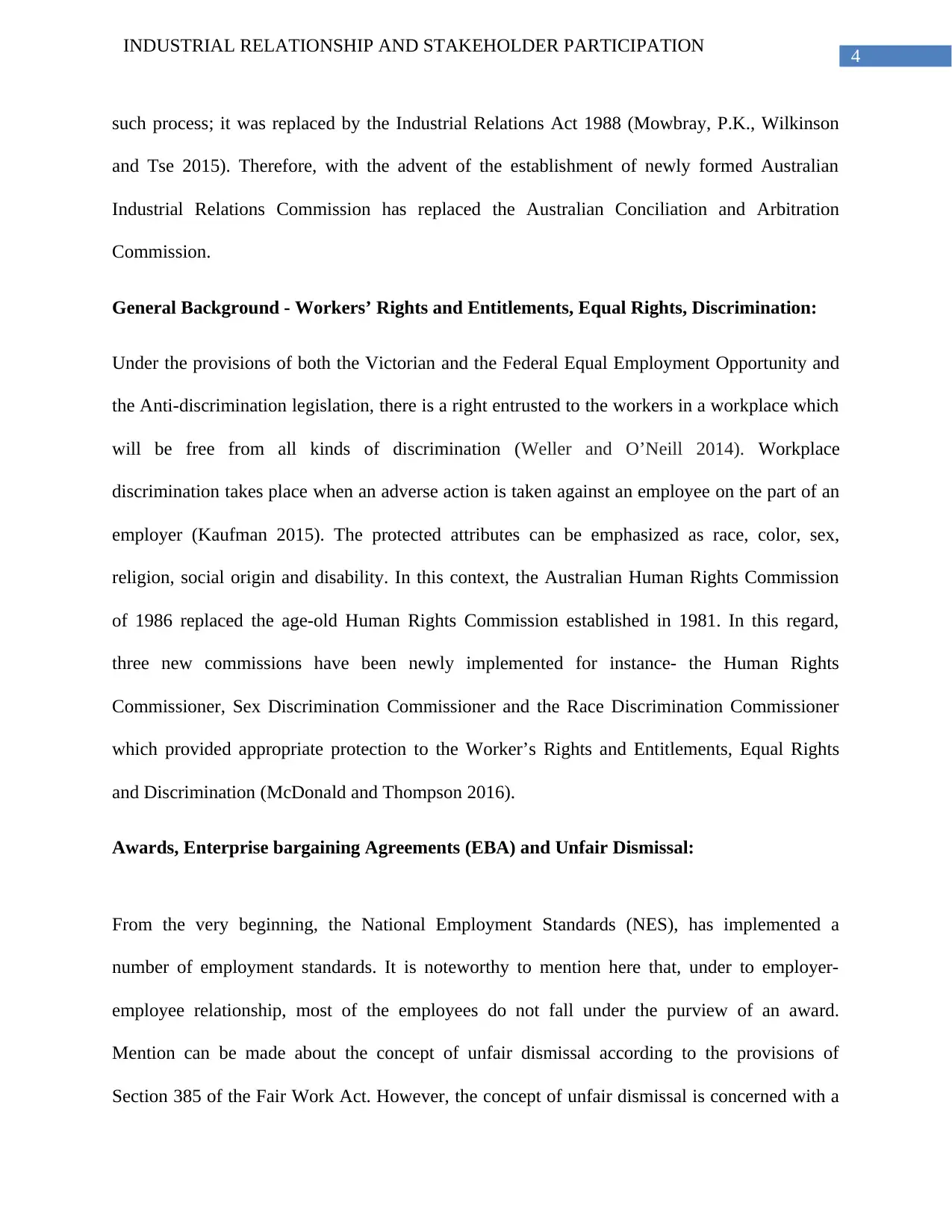
4
INDUSTRIAL RELATIONSHIP AND STAKEHOLDER PARTICIPATION
such process; it was replaced by the Industrial Relations Act 1988 (Mowbray, P.K., Wilkinson
and Tse 2015). Therefore, with the advent of the establishment of newly formed Australian
Industrial Relations Commission has replaced the Australian Conciliation and Arbitration
Commission.
General Background - Workers’ Rights and Entitlements, Equal Rights, Discrimination:
Under the provisions of both the Victorian and the Federal Equal Employment Opportunity and
the Anti-discrimination legislation, there is a right entrusted to the workers in a workplace which
will be free from all kinds of discrimination (Weller and O’Neill 2014). Workplace
discrimination takes place when an adverse action is taken against an employee on the part of an
employer (Kaufman 2015). The protected attributes can be emphasized as race, color, sex,
religion, social origin and disability. In this context, the Australian Human Rights Commission
of 1986 replaced the age-old Human Rights Commission established in 1981. In this regard,
three new commissions have been newly implemented for instance- the Human Rights
Commissioner, Sex Discrimination Commissioner and the Race Discrimination Commissioner
which provided appropriate protection to the Worker’s Rights and Entitlements, Equal Rights
and Discrimination (McDonald and Thompson 2016).
Awards, Enterprise bargaining Agreements (EBA) and Unfair Dismissal:
From the very beginning, the National Employment Standards (NES), has implemented a
number of employment standards. It is noteworthy to mention here that, under to employer-
employee relationship, most of the employees do not fall under the purview of an award.
Mention can be made about the concept of unfair dismissal according to the provisions of
Section 385 of the Fair Work Act. However, the concept of unfair dismissal is concerned with a
INDUSTRIAL RELATIONSHIP AND STAKEHOLDER PARTICIPATION
such process; it was replaced by the Industrial Relations Act 1988 (Mowbray, P.K., Wilkinson
and Tse 2015). Therefore, with the advent of the establishment of newly formed Australian
Industrial Relations Commission has replaced the Australian Conciliation and Arbitration
Commission.
General Background - Workers’ Rights and Entitlements, Equal Rights, Discrimination:
Under the provisions of both the Victorian and the Federal Equal Employment Opportunity and
the Anti-discrimination legislation, there is a right entrusted to the workers in a workplace which
will be free from all kinds of discrimination (Weller and O’Neill 2014). Workplace
discrimination takes place when an adverse action is taken against an employee on the part of an
employer (Kaufman 2015). The protected attributes can be emphasized as race, color, sex,
religion, social origin and disability. In this context, the Australian Human Rights Commission
of 1986 replaced the age-old Human Rights Commission established in 1981. In this regard,
three new commissions have been newly implemented for instance- the Human Rights
Commissioner, Sex Discrimination Commissioner and the Race Discrimination Commissioner
which provided appropriate protection to the Worker’s Rights and Entitlements, Equal Rights
and Discrimination (McDonald and Thompson 2016).
Awards, Enterprise bargaining Agreements (EBA) and Unfair Dismissal:
From the very beginning, the National Employment Standards (NES), has implemented a
number of employment standards. It is noteworthy to mention here that, under to employer-
employee relationship, most of the employees do not fall under the purview of an award.
Mention can be made about the concept of unfair dismissal according to the provisions of
Section 385 of the Fair Work Act. However, the concept of unfair dismissal is concerned with a
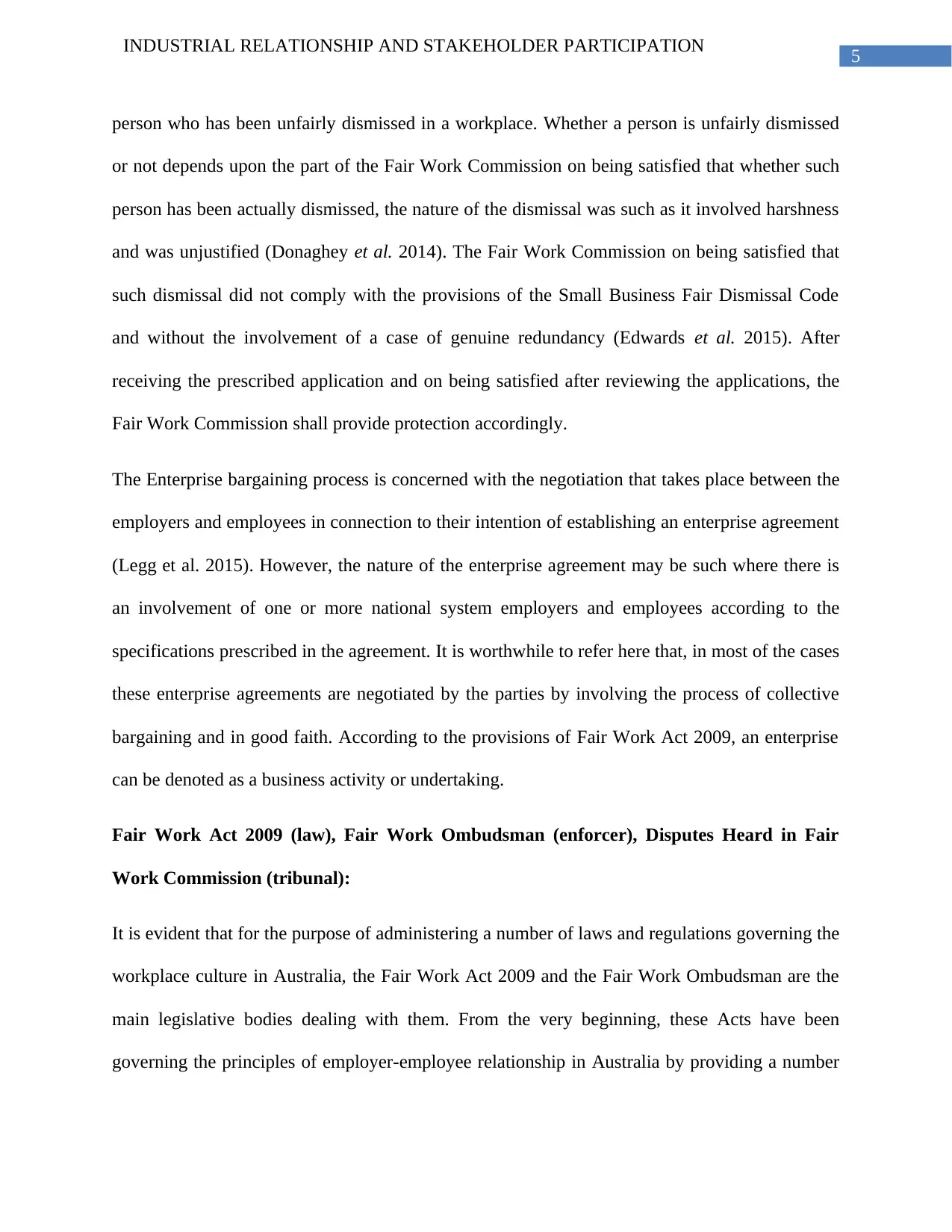
5
INDUSTRIAL RELATIONSHIP AND STAKEHOLDER PARTICIPATION
person who has been unfairly dismissed in a workplace. Whether a person is unfairly dismissed
or not depends upon the part of the Fair Work Commission on being satisfied that whether such
person has been actually dismissed, the nature of the dismissal was such as it involved harshness
and was unjustified (Donaghey et al. 2014). The Fair Work Commission on being satisfied that
such dismissal did not comply with the provisions of the Small Business Fair Dismissal Code
and without the involvement of a case of genuine redundancy (Edwards et al. 2015). After
receiving the prescribed application and on being satisfied after reviewing the applications, the
Fair Work Commission shall provide protection accordingly.
The Enterprise bargaining process is concerned with the negotiation that takes place between the
employers and employees in connection to their intention of establishing an enterprise agreement
(Legg et al. 2015). However, the nature of the enterprise agreement may be such where there is
an involvement of one or more national system employers and employees according to the
specifications prescribed in the agreement. It is worthwhile to refer here that, in most of the cases
these enterprise agreements are negotiated by the parties by involving the process of collective
bargaining and in good faith. According to the provisions of Fair Work Act 2009, an enterprise
can be denoted as a business activity or undertaking.
Fair Work Act 2009 (law), Fair Work Ombudsman (enforcer), Disputes Heard in Fair
Work Commission (tribunal):
It is evident that for the purpose of administering a number of laws and regulations governing the
workplace culture in Australia, the Fair Work Act 2009 and the Fair Work Ombudsman are the
main legislative bodies dealing with them. From the very beginning, these Acts have been
governing the principles of employer-employee relationship in Australia by providing a number
INDUSTRIAL RELATIONSHIP AND STAKEHOLDER PARTICIPATION
person who has been unfairly dismissed in a workplace. Whether a person is unfairly dismissed
or not depends upon the part of the Fair Work Commission on being satisfied that whether such
person has been actually dismissed, the nature of the dismissal was such as it involved harshness
and was unjustified (Donaghey et al. 2014). The Fair Work Commission on being satisfied that
such dismissal did not comply with the provisions of the Small Business Fair Dismissal Code
and without the involvement of a case of genuine redundancy (Edwards et al. 2015). After
receiving the prescribed application and on being satisfied after reviewing the applications, the
Fair Work Commission shall provide protection accordingly.
The Enterprise bargaining process is concerned with the negotiation that takes place between the
employers and employees in connection to their intention of establishing an enterprise agreement
(Legg et al. 2015). However, the nature of the enterprise agreement may be such where there is
an involvement of one or more national system employers and employees according to the
specifications prescribed in the agreement. It is worthwhile to refer here that, in most of the cases
these enterprise agreements are negotiated by the parties by involving the process of collective
bargaining and in good faith. According to the provisions of Fair Work Act 2009, an enterprise
can be denoted as a business activity or undertaking.
Fair Work Act 2009 (law), Fair Work Ombudsman (enforcer), Disputes Heard in Fair
Work Commission (tribunal):
It is evident that for the purpose of administering a number of laws and regulations governing the
workplace culture in Australia, the Fair Work Act 2009 and the Fair Work Ombudsman are the
main legislative bodies dealing with them. From the very beginning, these Acts have been
governing the principles of employer-employee relationship in Australia by providing a number
⊘ This is a preview!⊘
Do you want full access?
Subscribe today to unlock all pages.

Trusted by 1+ million students worldwide
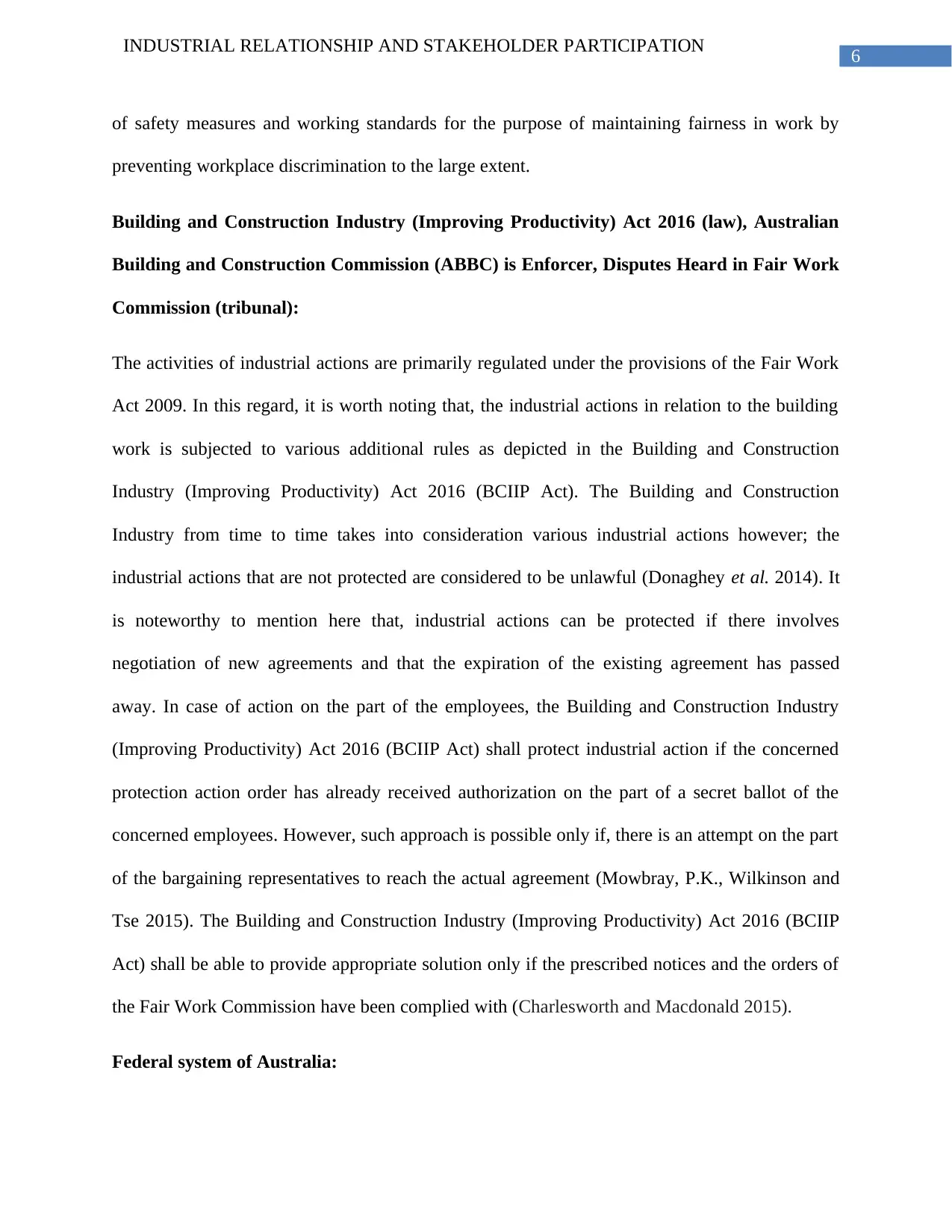
6
INDUSTRIAL RELATIONSHIP AND STAKEHOLDER PARTICIPATION
of safety measures and working standards for the purpose of maintaining fairness in work by
preventing workplace discrimination to the large extent.
Building and Construction Industry (Improving Productivity) Act 2016 (law), Australian
Building and Construction Commission (ABBC) is Enforcer, Disputes Heard in Fair Work
Commission (tribunal):
The activities of industrial actions are primarily regulated under the provisions of the Fair Work
Act 2009. In this regard, it is worth noting that, the industrial actions in relation to the building
work is subjected to various additional rules as depicted in the Building and Construction
Industry (Improving Productivity) Act 2016 (BCIIP Act). The Building and Construction
Industry from time to time takes into consideration various industrial actions however; the
industrial actions that are not protected are considered to be unlawful (Donaghey et al. 2014). It
is noteworthy to mention here that, industrial actions can be protected if there involves
negotiation of new agreements and that the expiration of the existing agreement has passed
away. In case of action on the part of the employees, the Building and Construction Industry
(Improving Productivity) Act 2016 (BCIIP Act) shall protect industrial action if the concerned
protection action order has already received authorization on the part of a secret ballot of the
concerned employees. However, such approach is possible only if, there is an attempt on the part
of the bargaining representatives to reach the actual agreement (Mowbray, P.K., Wilkinson and
Tse 2015). The Building and Construction Industry (Improving Productivity) Act 2016 (BCIIP
Act) shall be able to provide appropriate solution only if the prescribed notices and the orders of
the Fair Work Commission have been complied with (Charlesworth and Macdonald 2015).
Federal system of Australia:
INDUSTRIAL RELATIONSHIP AND STAKEHOLDER PARTICIPATION
of safety measures and working standards for the purpose of maintaining fairness in work by
preventing workplace discrimination to the large extent.
Building and Construction Industry (Improving Productivity) Act 2016 (law), Australian
Building and Construction Commission (ABBC) is Enforcer, Disputes Heard in Fair Work
Commission (tribunal):
The activities of industrial actions are primarily regulated under the provisions of the Fair Work
Act 2009. In this regard, it is worth noting that, the industrial actions in relation to the building
work is subjected to various additional rules as depicted in the Building and Construction
Industry (Improving Productivity) Act 2016 (BCIIP Act). The Building and Construction
Industry from time to time takes into consideration various industrial actions however; the
industrial actions that are not protected are considered to be unlawful (Donaghey et al. 2014). It
is noteworthy to mention here that, industrial actions can be protected if there involves
negotiation of new agreements and that the expiration of the existing agreement has passed
away. In case of action on the part of the employees, the Building and Construction Industry
(Improving Productivity) Act 2016 (BCIIP Act) shall protect industrial action if the concerned
protection action order has already received authorization on the part of a secret ballot of the
concerned employees. However, such approach is possible only if, there is an attempt on the part
of the bargaining representatives to reach the actual agreement (Mowbray, P.K., Wilkinson and
Tse 2015). The Building and Construction Industry (Improving Productivity) Act 2016 (BCIIP
Act) shall be able to provide appropriate solution only if the prescribed notices and the orders of
the Fair Work Commission have been complied with (Charlesworth and Macdonald 2015).
Federal system of Australia:
Paraphrase This Document
Need a fresh take? Get an instant paraphrase of this document with our AI Paraphraser
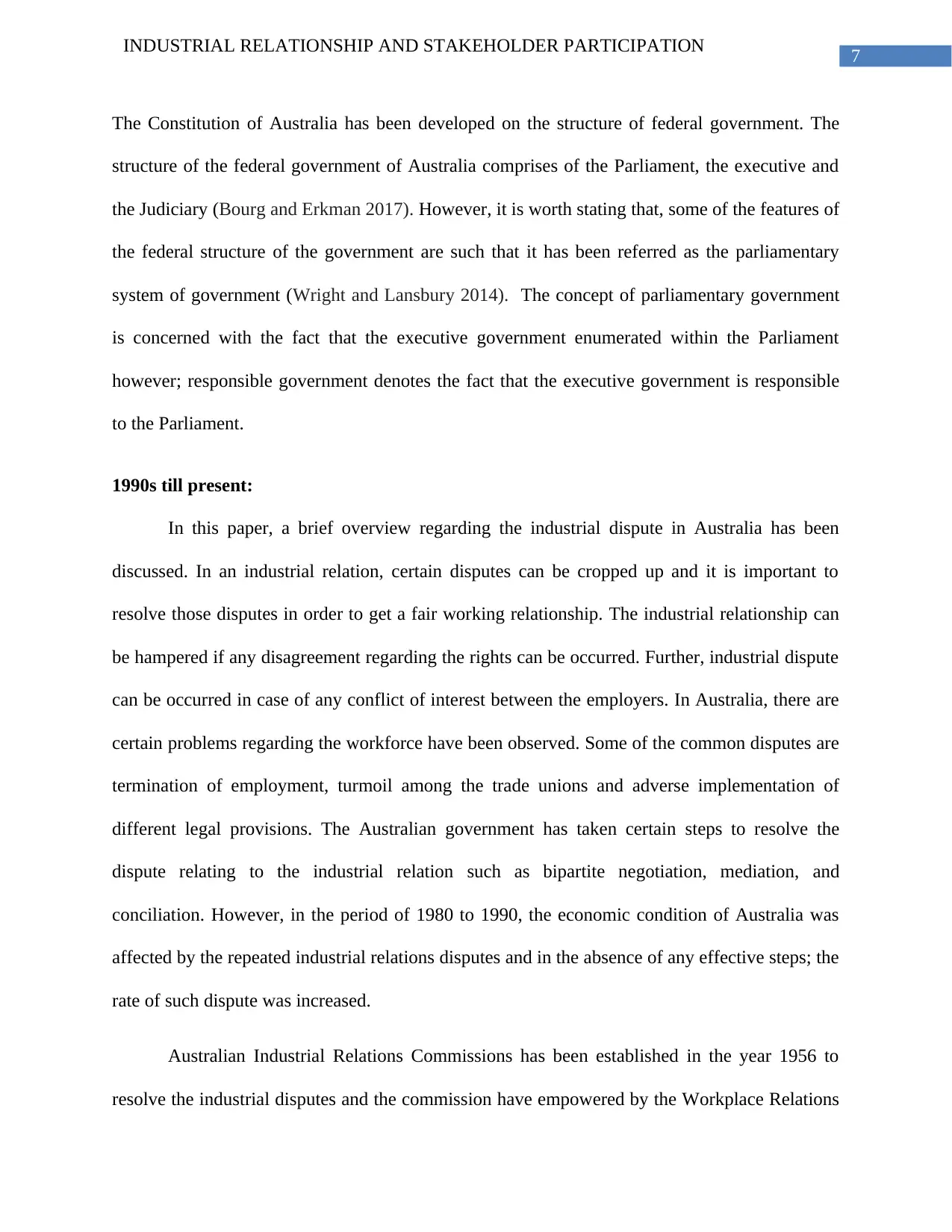
7
INDUSTRIAL RELATIONSHIP AND STAKEHOLDER PARTICIPATION
The Constitution of Australia has been developed on the structure of federal government. The
structure of the federal government of Australia comprises of the Parliament, the executive and
the Judiciary (Bourg and Erkman 2017). However, it is worth stating that, some of the features of
the federal structure of the government are such that it has been referred as the parliamentary
system of government (Wright and Lansbury 2014). The concept of parliamentary government
is concerned with the fact that the executive government enumerated within the Parliament
however; responsible government denotes the fact that the executive government is responsible
to the Parliament.
1990s till present:
In this paper, a brief overview regarding the industrial dispute in Australia has been
discussed. In an industrial relation, certain disputes can be cropped up and it is important to
resolve those disputes in order to get a fair working relationship. The industrial relationship can
be hampered if any disagreement regarding the rights can be occurred. Further, industrial dispute
can be occurred in case of any conflict of interest between the employers. In Australia, there are
certain problems regarding the workforce have been observed. Some of the common disputes are
termination of employment, turmoil among the trade unions and adverse implementation of
different legal provisions. The Australian government has taken certain steps to resolve the
dispute relating to the industrial relation such as bipartite negotiation, mediation, and
conciliation. However, in the period of 1980 to 1990, the economic condition of Australia was
affected by the repeated industrial relations disputes and in the absence of any effective steps; the
rate of such dispute was increased.
Australian Industrial Relations Commissions has been established in the year 1956 to
resolve the industrial disputes and the commission have empowered by the Workplace Relations
INDUSTRIAL RELATIONSHIP AND STAKEHOLDER PARTICIPATION
The Constitution of Australia has been developed on the structure of federal government. The
structure of the federal government of Australia comprises of the Parliament, the executive and
the Judiciary (Bourg and Erkman 2017). However, it is worth stating that, some of the features of
the federal structure of the government are such that it has been referred as the parliamentary
system of government (Wright and Lansbury 2014). The concept of parliamentary government
is concerned with the fact that the executive government enumerated within the Parliament
however; responsible government denotes the fact that the executive government is responsible
to the Parliament.
1990s till present:
In this paper, a brief overview regarding the industrial dispute in Australia has been
discussed. In an industrial relation, certain disputes can be cropped up and it is important to
resolve those disputes in order to get a fair working relationship. The industrial relationship can
be hampered if any disagreement regarding the rights can be occurred. Further, industrial dispute
can be occurred in case of any conflict of interest between the employers. In Australia, there are
certain problems regarding the workforce have been observed. Some of the common disputes are
termination of employment, turmoil among the trade unions and adverse implementation of
different legal provisions. The Australian government has taken certain steps to resolve the
dispute relating to the industrial relation such as bipartite negotiation, mediation, and
conciliation. However, in the period of 1980 to 1990, the economic condition of Australia was
affected by the repeated industrial relations disputes and in the absence of any effective steps; the
rate of such dispute was increased.
Australian Industrial Relations Commissions has been established in the year 1956 to
resolve the industrial disputes and the commission have empowered by the Workplace Relations
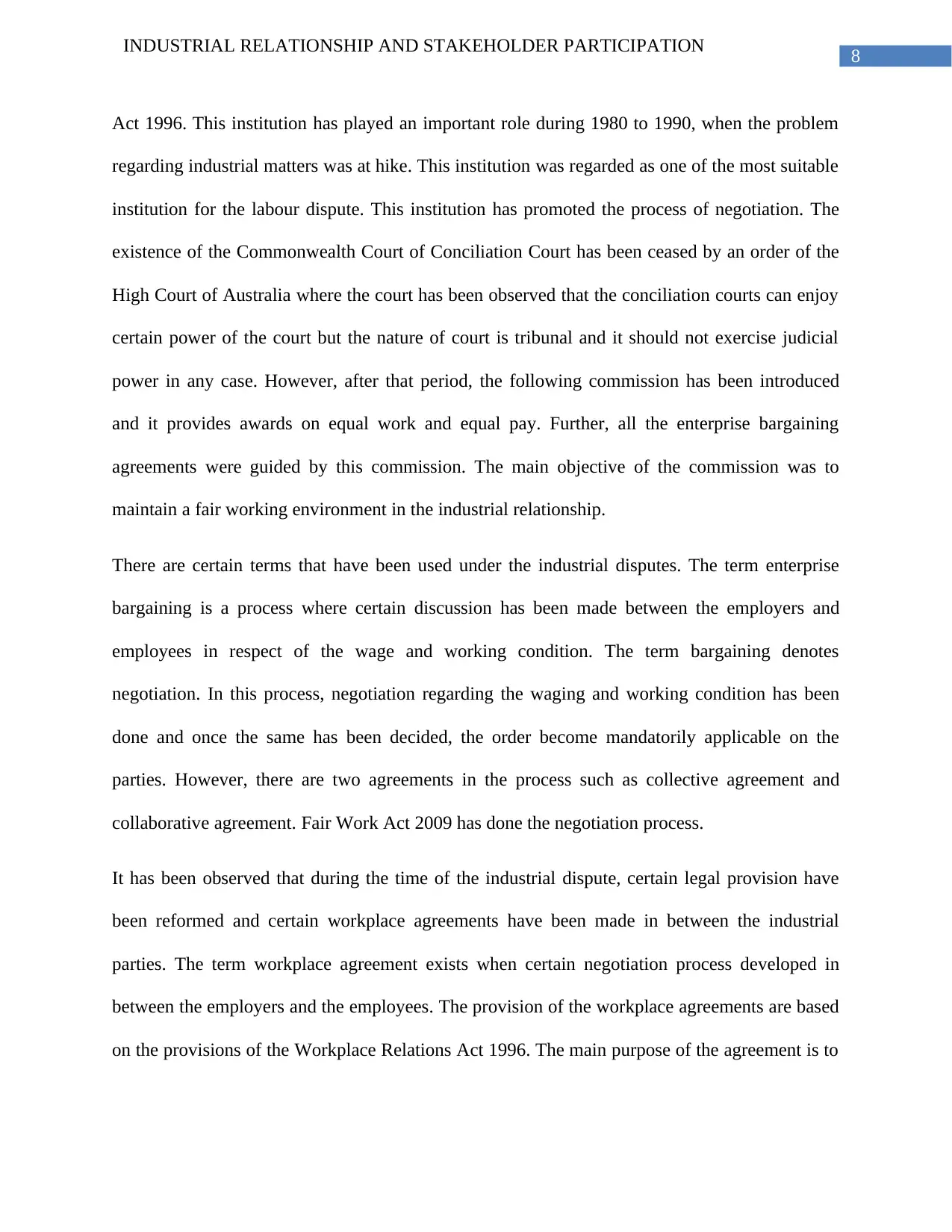
8
INDUSTRIAL RELATIONSHIP AND STAKEHOLDER PARTICIPATION
Act 1996. This institution has played an important role during 1980 to 1990, when the problem
regarding industrial matters was at hike. This institution was regarded as one of the most suitable
institution for the labour dispute. This institution has promoted the process of negotiation. The
existence of the Commonwealth Court of Conciliation Court has been ceased by an order of the
High Court of Australia where the court has been observed that the conciliation courts can enjoy
certain power of the court but the nature of court is tribunal and it should not exercise judicial
power in any case. However, after that period, the following commission has been introduced
and it provides awards on equal work and equal pay. Further, all the enterprise bargaining
agreements were guided by this commission. The main objective of the commission was to
maintain a fair working environment in the industrial relationship.
There are certain terms that have been used under the industrial disputes. The term enterprise
bargaining is a process where certain discussion has been made between the employers and
employees in respect of the wage and working condition. The term bargaining denotes
negotiation. In this process, negotiation regarding the waging and working condition has been
done and once the same has been decided, the order become mandatorily applicable on the
parties. However, there are two agreements in the process such as collective agreement and
collaborative agreement. Fair Work Act 2009 has done the negotiation process.
It has been observed that during the time of the industrial dispute, certain legal provision have
been reformed and certain workplace agreements have been made in between the industrial
parties. The term workplace agreement exists when certain negotiation process developed in
between the employers and the employees. The provision of the workplace agreements are based
on the provisions of the Workplace Relations Act 1996. The main purpose of the agreement is to
INDUSTRIAL RELATIONSHIP AND STAKEHOLDER PARTICIPATION
Act 1996. This institution has played an important role during 1980 to 1990, when the problem
regarding industrial matters was at hike. This institution was regarded as one of the most suitable
institution for the labour dispute. This institution has promoted the process of negotiation. The
existence of the Commonwealth Court of Conciliation Court has been ceased by an order of the
High Court of Australia where the court has been observed that the conciliation courts can enjoy
certain power of the court but the nature of court is tribunal and it should not exercise judicial
power in any case. However, after that period, the following commission has been introduced
and it provides awards on equal work and equal pay. Further, all the enterprise bargaining
agreements were guided by this commission. The main objective of the commission was to
maintain a fair working environment in the industrial relationship.
There are certain terms that have been used under the industrial disputes. The term enterprise
bargaining is a process where certain discussion has been made between the employers and
employees in respect of the wage and working condition. The term bargaining denotes
negotiation. In this process, negotiation regarding the waging and working condition has been
done and once the same has been decided, the order become mandatorily applicable on the
parties. However, there are two agreements in the process such as collective agreement and
collaborative agreement. Fair Work Act 2009 has done the negotiation process.
It has been observed that during the time of the industrial dispute, certain legal provision have
been reformed and certain workplace agreements have been made in between the industrial
parties. The term workplace agreement exists when certain negotiation process developed in
between the employers and the employees. The provision of the workplace agreements are based
on the provisions of the Workplace Relations Act 1996. The main purpose of the agreement is to
⊘ This is a preview!⊘
Do you want full access?
Subscribe today to unlock all pages.

Trusted by 1+ million students worldwide
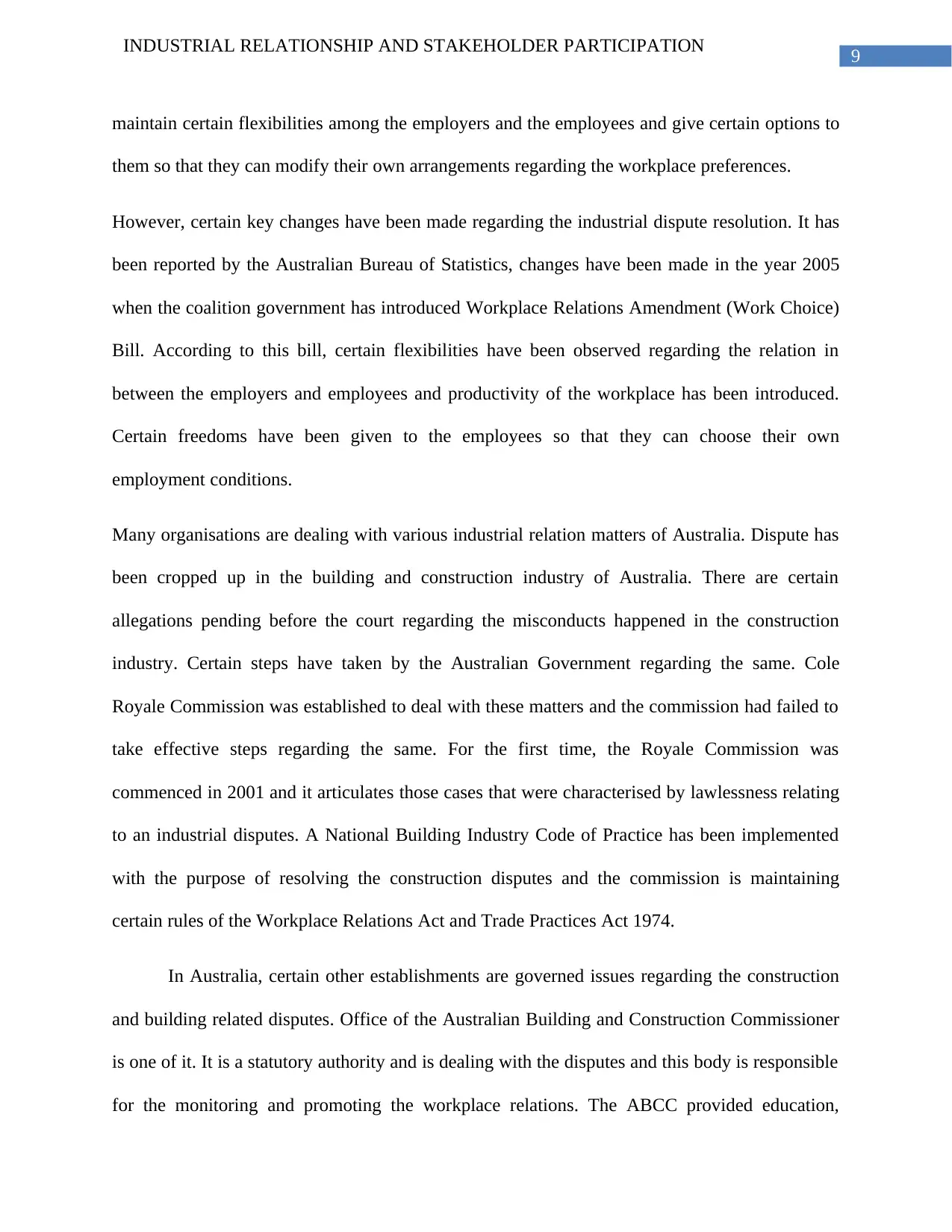
9
INDUSTRIAL RELATIONSHIP AND STAKEHOLDER PARTICIPATION
maintain certain flexibilities among the employers and the employees and give certain options to
them so that they can modify their own arrangements regarding the workplace preferences.
However, certain key changes have been made regarding the industrial dispute resolution. It has
been reported by the Australian Bureau of Statistics, changes have been made in the year 2005
when the coalition government has introduced Workplace Relations Amendment (Work Choice)
Bill. According to this bill, certain flexibilities have been observed regarding the relation in
between the employers and employees and productivity of the workplace has been introduced.
Certain freedoms have been given to the employees so that they can choose their own
employment conditions.
Many organisations are dealing with various industrial relation matters of Australia. Dispute has
been cropped up in the building and construction industry of Australia. There are certain
allegations pending before the court regarding the misconducts happened in the construction
industry. Certain steps have taken by the Australian Government regarding the same. Cole
Royale Commission was established to deal with these matters and the commission had failed to
take effective steps regarding the same. For the first time, the Royale Commission was
commenced in 2001 and it articulates those cases that were characterised by lawlessness relating
to an industrial disputes. A National Building Industry Code of Practice has been implemented
with the purpose of resolving the construction disputes and the commission is maintaining
certain rules of the Workplace Relations Act and Trade Practices Act 1974.
In Australia, certain other establishments are governed issues regarding the construction
and building related disputes. Office of the Australian Building and Construction Commissioner
is one of it. It is a statutory authority and is dealing with the disputes and this body is responsible
for the monitoring and promoting the workplace relations. The ABCC provided education,
INDUSTRIAL RELATIONSHIP AND STAKEHOLDER PARTICIPATION
maintain certain flexibilities among the employers and the employees and give certain options to
them so that they can modify their own arrangements regarding the workplace preferences.
However, certain key changes have been made regarding the industrial dispute resolution. It has
been reported by the Australian Bureau of Statistics, changes have been made in the year 2005
when the coalition government has introduced Workplace Relations Amendment (Work Choice)
Bill. According to this bill, certain flexibilities have been observed regarding the relation in
between the employers and employees and productivity of the workplace has been introduced.
Certain freedoms have been given to the employees so that they can choose their own
employment conditions.
Many organisations are dealing with various industrial relation matters of Australia. Dispute has
been cropped up in the building and construction industry of Australia. There are certain
allegations pending before the court regarding the misconducts happened in the construction
industry. Certain steps have taken by the Australian Government regarding the same. Cole
Royale Commission was established to deal with these matters and the commission had failed to
take effective steps regarding the same. For the first time, the Royale Commission was
commenced in 2001 and it articulates those cases that were characterised by lawlessness relating
to an industrial disputes. A National Building Industry Code of Practice has been implemented
with the purpose of resolving the construction disputes and the commission is maintaining
certain rules of the Workplace Relations Act and Trade Practices Act 1974.
In Australia, certain other establishments are governed issues regarding the construction
and building related disputes. Office of the Australian Building and Construction Commissioner
is one of it. It is a statutory authority and is dealing with the disputes and this body is responsible
for the monitoring and promoting the workplace relations. The ABCC provided education,
Paraphrase This Document
Need a fresh take? Get an instant paraphrase of this document with our AI Paraphraser
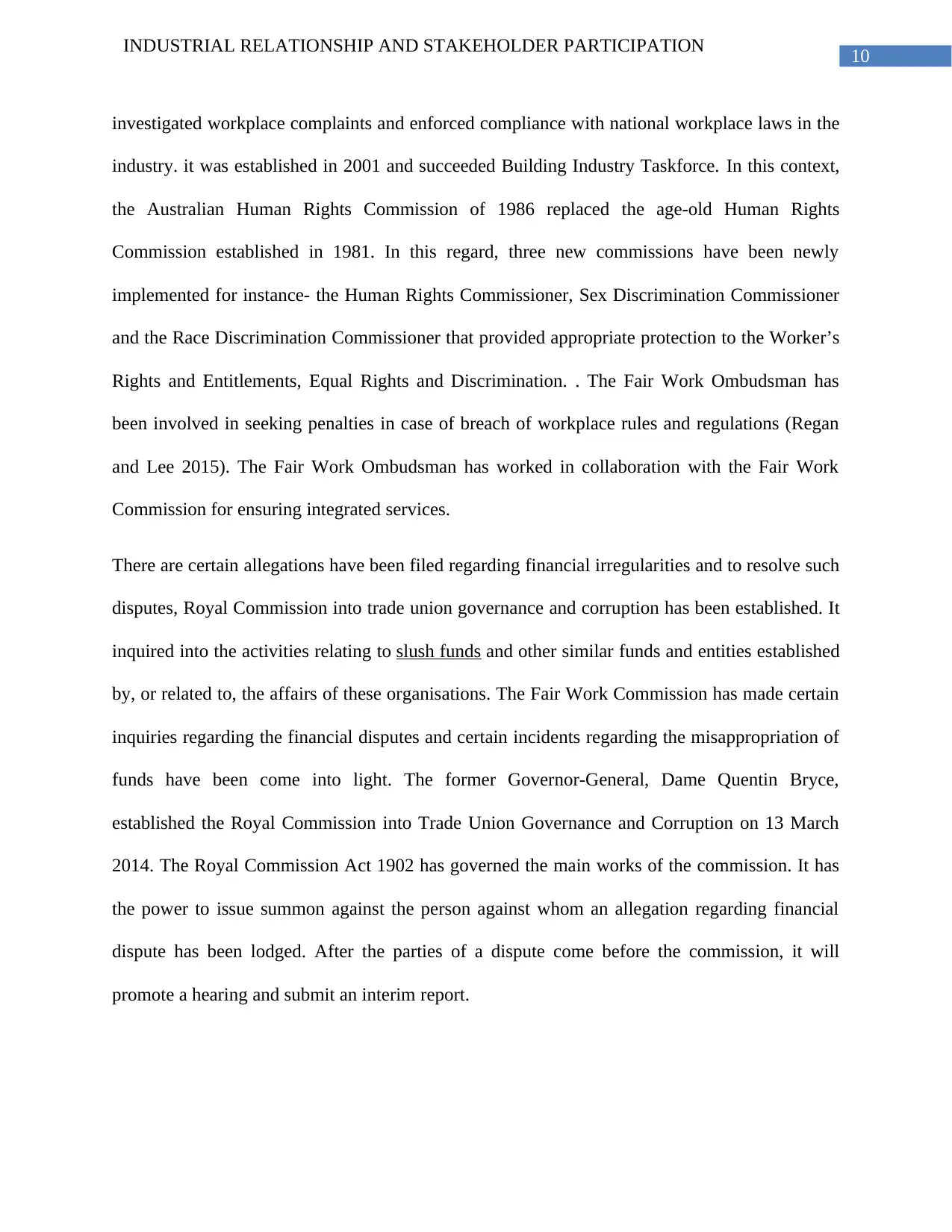
10
INDUSTRIAL RELATIONSHIP AND STAKEHOLDER PARTICIPATION
investigated workplace complaints and enforced compliance with national workplace laws in the
industry. it was established in 2001 and succeeded Building Industry Taskforce. In this context,
the Australian Human Rights Commission of 1986 replaced the age-old Human Rights
Commission established in 1981. In this regard, three new commissions have been newly
implemented for instance- the Human Rights Commissioner, Sex Discrimination Commissioner
and the Race Discrimination Commissioner that provided appropriate protection to the Worker’s
Rights and Entitlements, Equal Rights and Discrimination. . The Fair Work Ombudsman has
been involved in seeking penalties in case of breach of workplace rules and regulations (Regan
and Lee 2015). The Fair Work Ombudsman has worked in collaboration with the Fair Work
Commission for ensuring integrated services.
There are certain allegations have been filed regarding financial irregularities and to resolve such
disputes, Royal Commission into trade union governance and corruption has been established. It
inquired into the activities relating to slush funds and other similar funds and entities established
by, or related to, the affairs of these organisations. The Fair Work Commission has made certain
inquiries regarding the financial disputes and certain incidents regarding the misappropriation of
funds have been come into light. The former Governor-General, Dame Quentin Bryce,
established the Royal Commission into Trade Union Governance and Corruption on 13 March
2014. The Royal Commission Act 1902 has governed the main works of the commission. It has
the power to issue summon against the person against whom an allegation regarding financial
dispute has been lodged. After the parties of a dispute come before the commission, it will
promote a hearing and submit an interim report.
INDUSTRIAL RELATIONSHIP AND STAKEHOLDER PARTICIPATION
investigated workplace complaints and enforced compliance with national workplace laws in the
industry. it was established in 2001 and succeeded Building Industry Taskforce. In this context,
the Australian Human Rights Commission of 1986 replaced the age-old Human Rights
Commission established in 1981. In this regard, three new commissions have been newly
implemented for instance- the Human Rights Commissioner, Sex Discrimination Commissioner
and the Race Discrimination Commissioner that provided appropriate protection to the Worker’s
Rights and Entitlements, Equal Rights and Discrimination. . The Fair Work Ombudsman has
been involved in seeking penalties in case of breach of workplace rules and regulations (Regan
and Lee 2015). The Fair Work Ombudsman has worked in collaboration with the Fair Work
Commission for ensuring integrated services.
There are certain allegations have been filed regarding financial irregularities and to resolve such
disputes, Royal Commission into trade union governance and corruption has been established. It
inquired into the activities relating to slush funds and other similar funds and entities established
by, or related to, the affairs of these organisations. The Fair Work Commission has made certain
inquiries regarding the financial disputes and certain incidents regarding the misappropriation of
funds have been come into light. The former Governor-General, Dame Quentin Bryce,
established the Royal Commission into Trade Union Governance and Corruption on 13 March
2014. The Royal Commission Act 1902 has governed the main works of the commission. It has
the power to issue summon against the person against whom an allegation regarding financial
dispute has been lodged. After the parties of a dispute come before the commission, it will
promote a hearing and submit an interim report.
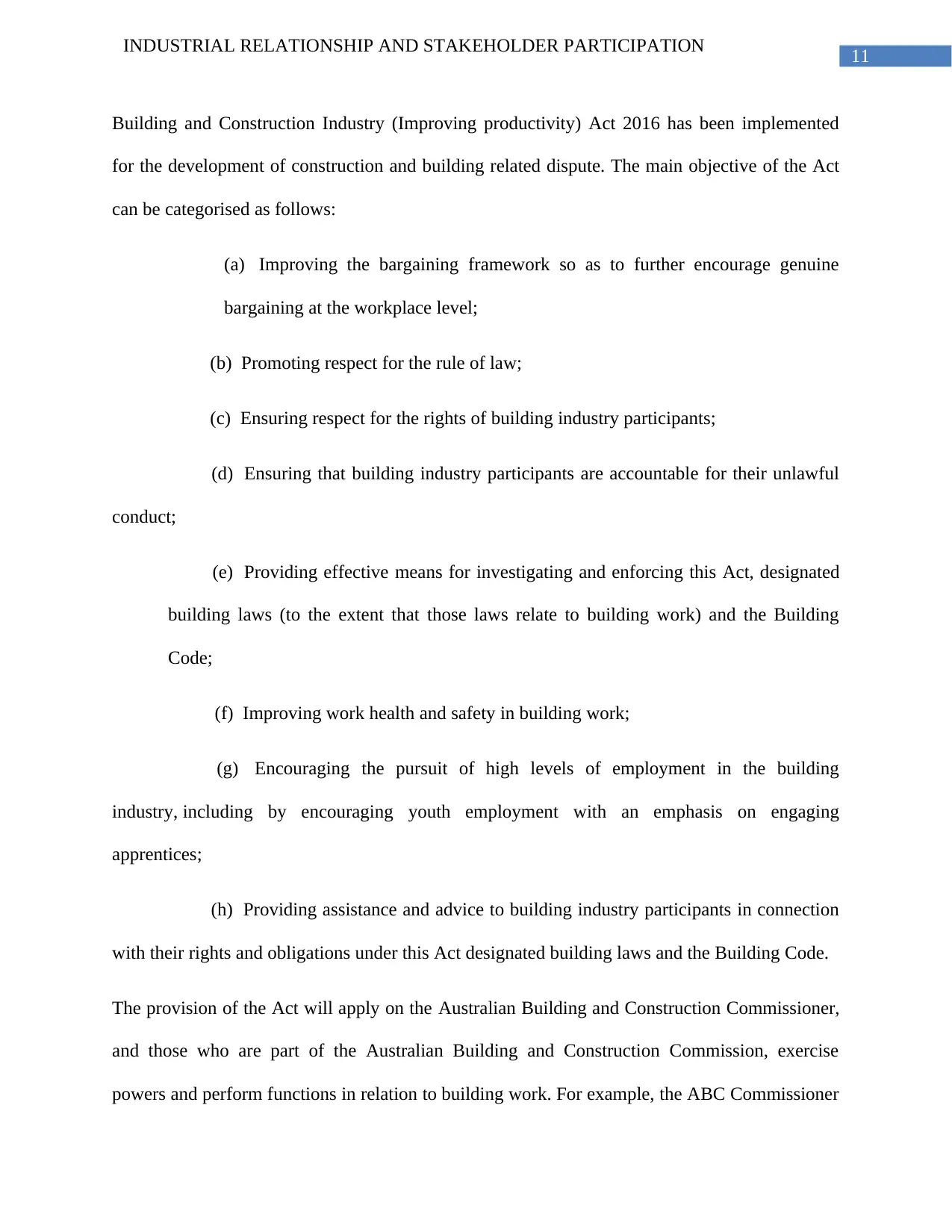
11
INDUSTRIAL RELATIONSHIP AND STAKEHOLDER PARTICIPATION
Building and Construction Industry (Improving productivity) Act 2016 has been implemented
for the development of construction and building related dispute. The main objective of the Act
can be categorised as follows:
(a) Improving the bargaining framework so as to further encourage genuine
bargaining at the workplace level;
(b) Promoting respect for the rule of law;
(c) Ensuring respect for the rights of building industry participants;
(d) Ensuring that building industry participants are accountable for their unlawful
conduct;
(e) Providing effective means for investigating and enforcing this Act, designated
building laws (to the extent that those laws relate to building work) and the Building
Code;
(f) Improving work health and safety in building work;
(g) Encouraging the pursuit of high levels of employment in the building
industry, including by encouraging youth employment with an emphasis on engaging
apprentices;
(h) Providing assistance and advice to building industry participants in connection
with their rights and obligations under this Act designated building laws and the Building Code.
The provision of the Act will apply on the Australian Building and Construction Commissioner,
and those who are part of the Australian Building and Construction Commission, exercise
powers and perform functions in relation to building work. For example, the ABC Commissioner
INDUSTRIAL RELATIONSHIP AND STAKEHOLDER PARTICIPATION
Building and Construction Industry (Improving productivity) Act 2016 has been implemented
for the development of construction and building related dispute. The main objective of the Act
can be categorised as follows:
(a) Improving the bargaining framework so as to further encourage genuine
bargaining at the workplace level;
(b) Promoting respect for the rule of law;
(c) Ensuring respect for the rights of building industry participants;
(d) Ensuring that building industry participants are accountable for their unlawful
conduct;
(e) Providing effective means for investigating and enforcing this Act, designated
building laws (to the extent that those laws relate to building work) and the Building
Code;
(f) Improving work health and safety in building work;
(g) Encouraging the pursuit of high levels of employment in the building
industry, including by encouraging youth employment with an emphasis on engaging
apprentices;
(h) Providing assistance and advice to building industry participants in connection
with their rights and obligations under this Act designated building laws and the Building Code.
The provision of the Act will apply on the Australian Building and Construction Commissioner,
and those who are part of the Australian Building and Construction Commission, exercise
powers and perform functions in relation to building work. For example, the ABC Commissioner
⊘ This is a preview!⊘
Do you want full access?
Subscribe today to unlock all pages.

Trusted by 1+ million students worldwide
1 out of 28
Related Documents
Your All-in-One AI-Powered Toolkit for Academic Success.
+13062052269
info@desklib.com
Available 24*7 on WhatsApp / Email
![[object Object]](/_next/static/media/star-bottom.7253800d.svg)
Unlock your academic potential
Copyright © 2020–2025 A2Z Services. All Rights Reserved. Developed and managed by ZUCOL.




